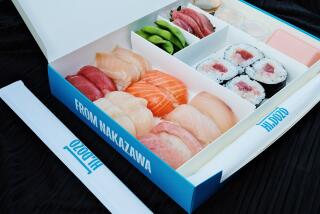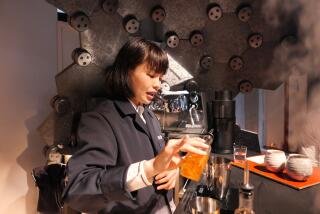Need a Breath of Fresh Air? In Japan, All You Have to Do Is Belly Up to the Bar
- Share via
TOKYO — What price fresh air? In Tokyo it’s the equivalent of 75 cents a whiff.
Canned oxygen is becoming a big seller in Japan, and a new breed of bar is beginning to spring up in Tokyo selling hits of the invisible gas that most people breathe in free of charge.
“A power plant that recharges human beings,” proclaims one oxygen ad.
The first “O2 bar,” with a simple counter and several chairs under blue lights, made its debut in October in the sporting goods section at one of Tokyo’s major department stores, Takashimaya.
95% Pure Oxygen
A male attendant and female clerks cater to customers who turn up to inhale three minutes of 95% pure oxygen for about 75 cents.
Customers can choose oxygen scented with peppermint, coffee, lemon or mushroom through a wine glass-shaped mask.
“We’ve had a larger than expected turnout of some 50 people daily,” Hiromitsu Morii, a Takashimaya spokesman, said.
The oxygen barman, Masaru Kageyama, added: “Most people say they feel refreshed after trying the oxygen. But it seems that those who are quite healthy or expect too much do not feel any noticeable effects.”
Neutralizer for Smoking?
“I don’t feel much effect,” said a middle-aged businessman after a sample whiff. “But I will buy a can to take home, because my colleagues say it will help neutralize my heavy smoking.”
Several firms are competing in the fledgling canned oxygen market, with a five-quart can of condensed oxygen selling for between $5.30 and $11.30.
All say they are optimistic about prospects for the product.
Makers say that inhaling several deep whiffs from the cans give a refreshing feeling and hasten recovery from fatigue or a hangover. A five-quart cans contains two or three minutes worth of the gas, makers said.
Advertising Claims
“After long hours of strenuous workout, tense study, uncomfortable driving or a hectic meeting . . . a can of oxygen revitalizes your lungs with new, instant power,” trumpets one advertisement.
The makers are currently targetting sports enthusiasts, exhausted students and businessmen. But Japan’s growing population of old people is also seen as a potential market.
Since September, Nippon Sanso has marketed five-quart cans of 95% oxygen called Oxy. A company spokesman said that sales so far were close to the pace of its sales target of 1 million cans a year.
Yoshihisa Toichi of Daido Sanso said that more than 100,000 cans of peppermint-flavored O2n and O2ff, priced at $7.50 each, had been sold in the first three months since they went on the market last August.
Exceeding Expectations
“It’s more than we had anticipated,” he said.
Asked why oxygen was becoming popular, Nippon Sanso spokesman Akira Yamauchi said that Japanese people are more affluent, more aware of the pollution affecting the big cities and under greater stress in their daily lives than before.
“I think it is a demand of the times that people want things good to health,” he said.
Prof. Jun Yamakawa of the Nippon Women’s College of Physical Education said she thought that oxygen-sniffing would do healthy people little good.
“Unless you have gone through very strenuous exercise, inhaling purer oxygen would probably be more beneficial to your mind than to your body,” she said. “Deep breathing of natural air, about 21% of which is oxygen, would be enough to recover from normal exercise.”
More to Read
Inside the business of entertainment
The Wide Shot brings you news, analysis and insights on everything from streaming wars to production — and what it all means for the future.
You may occasionally receive promotional content from the Los Angeles Times.










